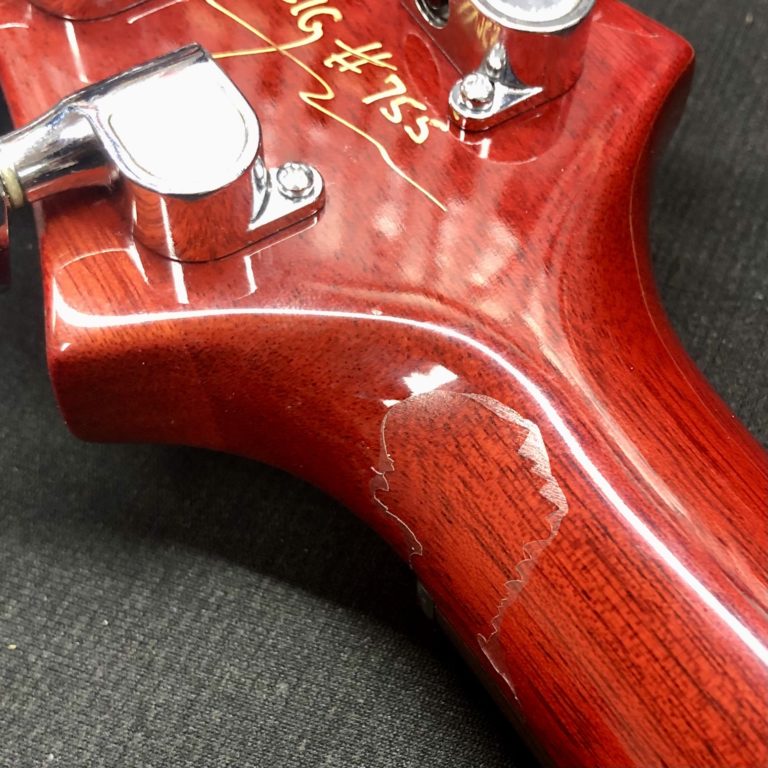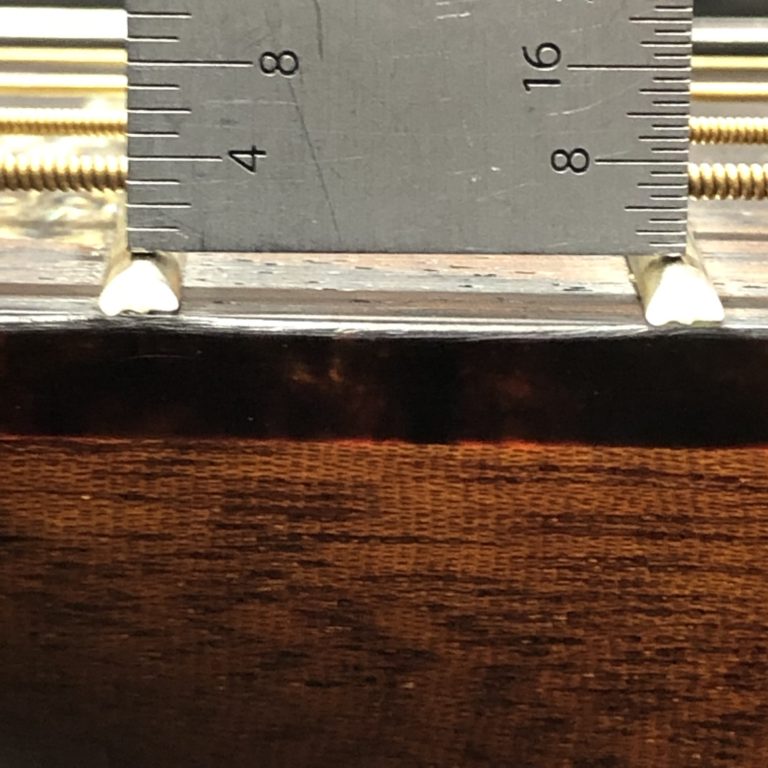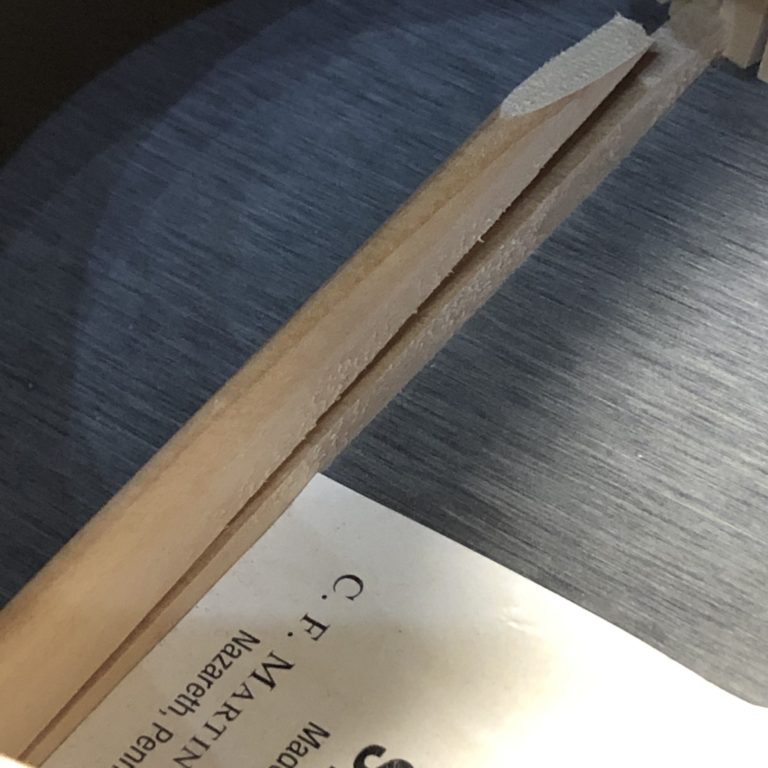How To Test A Guitar Before Buying:
What To Look For When Shopping For A Guitar or Bass.

There are many things to consider when shopping for a guitar or bass. It is easy to get blinded by excitement and overlook problems that might be right in front of your eyes!
After finding what is hopefully the model you want, in the right color, at a price you can afford, you will next want to be certain the guitar is healthy.
The following is a checklist of the types of things that we look for during an instrument evaluation. We hope that you will find the list helpful when performing your own evaluations prior to purchasing a guitar or bass.
Pre-Purchase Guitar Inspection Checklist
- Inspect the guitar for any dings, scratches or finish imperfections

Cosmetic condition can serve as a reasonable first indicator of how well the instrument has been cared for. Finish repairs can be difficult and costly to fix; We don’t recommend buying a guitar with finish imperfections unless you are prepared to live with them. (Even if you are okay with the aesthetics of the damage “as is”, noting cosmetic deficiencies may help you to negotiate a lower price.)
- Look At The Nut

Take a look at the nut. Does it look clean and well profiled? Do they sound true and clear? It’s best not to assume that bad notes will be a simple fix. An open string buzz may indicate a problem that will require replacement.
- Check the neck for straightness and make sure that the truss rod works

Even if the neck is straight now, there will come a time where it needs to be adjusted. For proper setup, it is important that the truss rod is functioning properly. (A healthy truss rod should be capable of both back bowing and forward bowing the neck.)
- Consider the string height of the guitar

Look at the guitar’s string height; Does it feel about right or is it way too high or too low? Slight changes in action adjustment are not usually a big deal but, if it doesn’t seem right, make sure a tech looks at the guitar before buying! Do not assume that it just needs a setup. Especially with an acoustic guitar, neck resets are a common, but sometimes costly, necessity over the instruments lifespan.
- Look at the frets

Are the fret ends sharp and rough? If so, they may benefit from a fret end dressing. Do the frets appear well seated in the fingerboard? Have flat spots and grooves been worn into the frets? If this has occurred, the instrument may benefit fretwork, or a refret, for the best playability.
- Electronics: Turn every knob and switch

Do any of the positions sound weak or thin? If possible, open up the control cavity to be certain the wiring looks clean and secure. (electrical tape is not a good sign) This is especially important if you think the guitar has been modified: I.E. new pickups, replaced controls, etc. If the guitar has a battery, be sure it is not expired and corroding the terminals.
- Examine the glue Joints and seams

Especially with acoustic instruments, take time to look at all the seams and glue joints on the instrument. Sight the top from the side in hopes of finding a gentle and smooth arch. A sunken top is often a telltale sign of humidity damage. Can you see any space where the bottom of the bridge meets the top? If so, it may need a bridge reglue. It may be worth using a mirror to inspect the bridge plate too. Does the neck join cleanly to the body? Is there any issues where the back or top joins the sides? Use your fingers to tap the top and back in several areas. Listen for any rattling or hollow sounds that might indicate issues with the internal bracing.
- Used/Vintage: Check if the hardware is original

Guitar players love to tweak and mod their instruments. Especially when buying a vintage piece, check out the hardware for originality. Swapped out parts can have a dramatic impact on the instruments value. Newer parts can be reliced to look aged.
Don't Get Stuck With A Lemon
If you have any questions about an instrument, it is best to bring it to a qualified luthier to get them answered before you buy or during the return period. The time spent can help you to confidently make your purchase, negotiate money off the price to pay for any necessary repairs, or save you from buying an instrument that just isn’t worth the hassle at any price!
If all looks good, and you do decide to buy, we strongly recommend bringing the instrument into the shop for a setup ASAP so that you can be confident that your purchase is in good shape and ready for years of music making.

Erik Salomon - Calico Guitarworks Owner / Head Technician
Tech Talk articles are part of an ongoing effort to provide clear and detailed answers to common questions about guitar maintenance, modifications, and repairs.
While not intended as a step-by-step guide to servicing your own instrument, we hope that you will find value in the information provided.

Great Repairs Start With The Right Parts
Many of the parts mentioned in our blogs are available for purchase at:
GuitarRepairParts.com
Enter the code "TechTalk10" at checkout for 10% off your first order.
About Calico Guitarworks
Calico Guitarworks is the area’s premier destination for fretted musical instrument care and maintenance. Owned and managed by Erik Salomon, the shop is dedicated to providing quick, honest and reliable service. The staff at Calico Guitarworks has a combined 25+ years of professional guitar repair experience. Sharing the knowledge that we accumulate in this focused pursuit is at the core of what we do. Learn more About Calico Guitarworks, explore our Frequently Asked Questions, or Contact us with a specific request.






